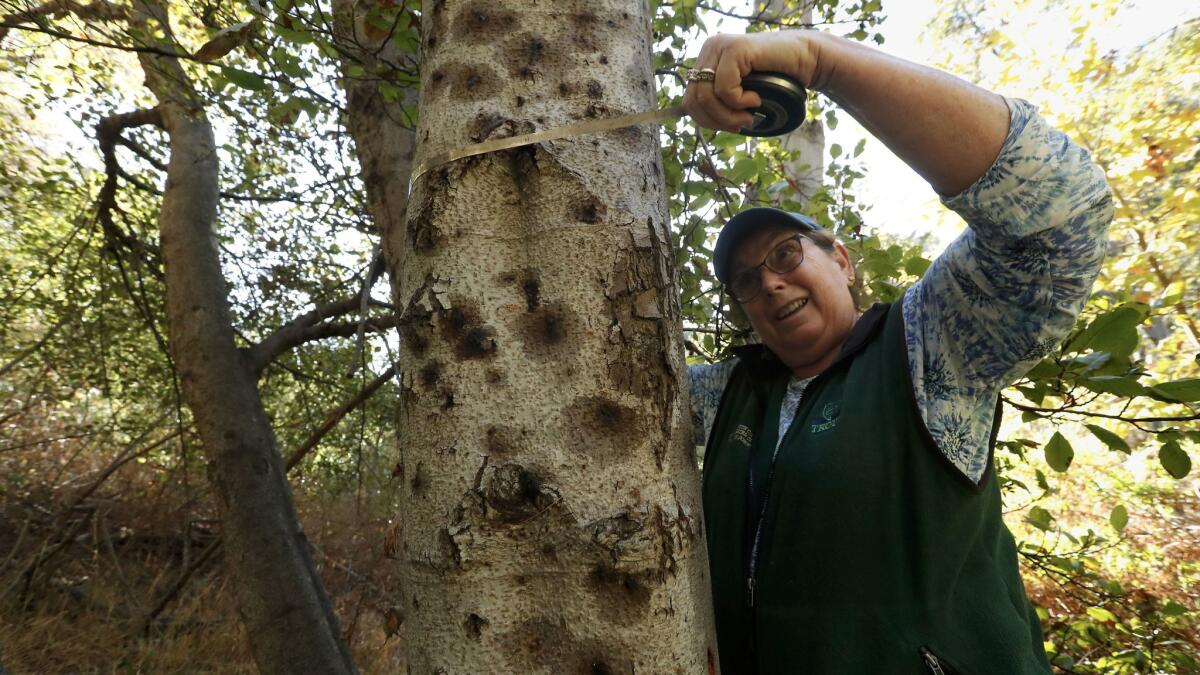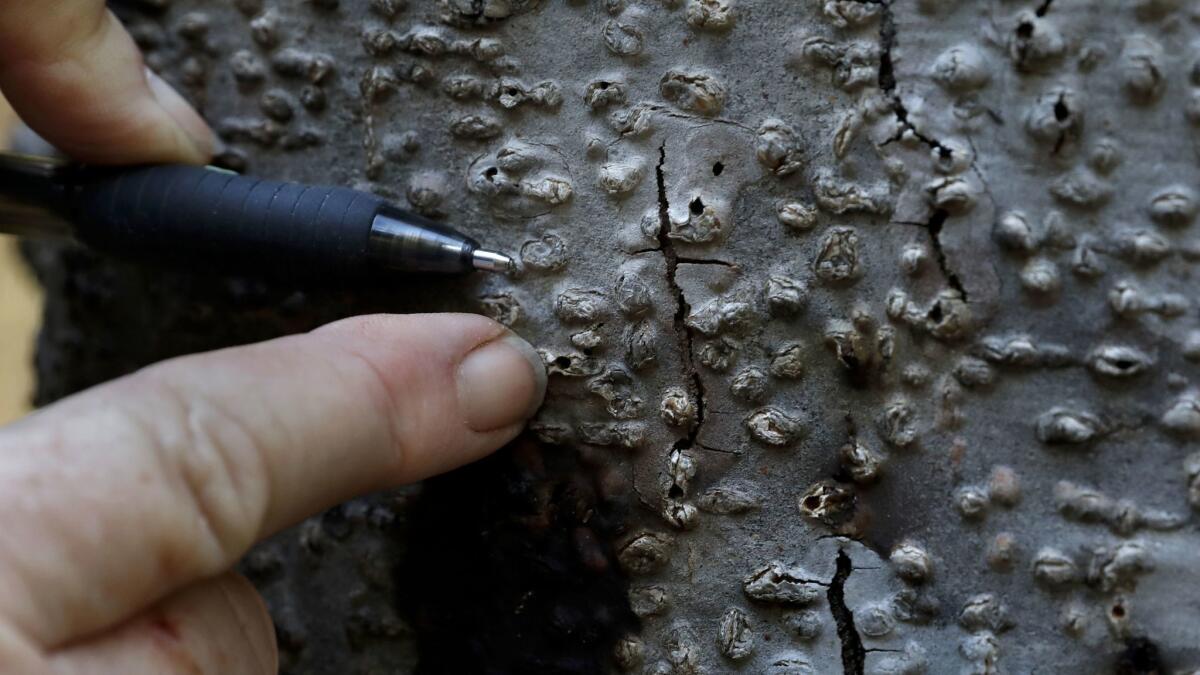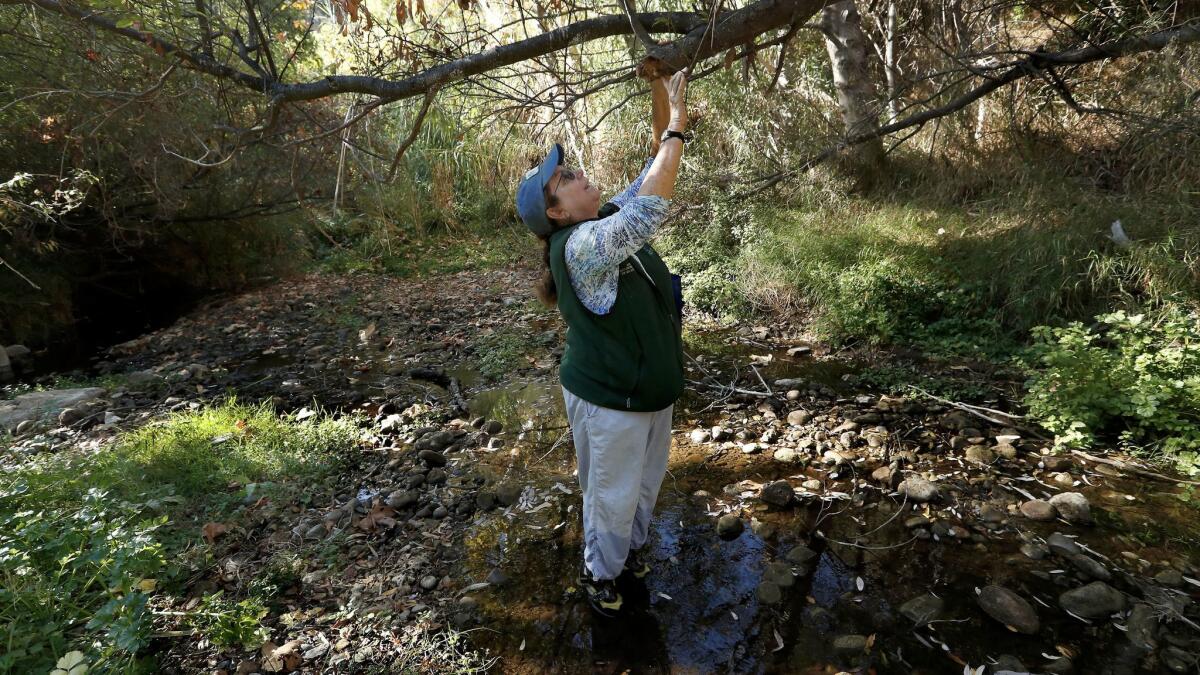Drought and bugs have killed tens of thousands of trees in the Santa Monica Mountains

- Share via
When biologist Rosi Dagit wants to give people a glimpse of the urgency of the problem afflicting trees in the Santa Monica Mountains, she takes them to a withering oasis in Topanga Canyon where hundreds of sycamores, alders and willows are dead and dying.
Just six years ago, the creek offered all the arboreal comforts needed for frogs, newts and protected fish such Arroyo chubs and steelhead trout to avoid extinction: leafy canopies to control water temperature and prevent algae blooms, and willows buzzing with insects for nourishment.
Now, streamside trees weakened by drought are being ravaged by fungal diseases and swarms of insects the size of sesame seeds — imperiling not only the lush canopy but all the creatures that live in the stream.

During a tour on Friday, Dagit saw damage almost everywhere she looked. Willows had lost their leaves from a fungal pathogen that coated their boughs with a crusty white residue. Sycamores and alders were splotched with half-dollar-size lesions caused by tiny beetles. Native shrubs were giving way to weeds.
On a 150-foot stretch of creek lined with 78 trees, Dagit counted only 15 still alive.
“The ecological consequences of losing all these trees are profound and, on a personal level, so sad,” said Dagit, a senior biologist for the Resource Conservation District of the Santa Monica Mountains.
New surveys of the 154,000-acre Santa Monica Mountains National Recreation Area conducted by remote sensing instruments on NASA aircraft and teams on the ground revealed a loss of about 9,100 — or 6% — of coast live oaks, and 114,000 — or 32% — of riparian trees including sycamores, alders and willows during five years of severe drought that ended in 2017. About 38% of the area’s chaparral also died, NASA scientists said.
Ripple effects on the environment may already be underway. For example, mayflies, which float on the surface and are an easily accessible food for fish and frogs, have been replaced by tiny chironomid midges, which spend much of their lives hiding in sunken leaves. Whether Topanga Canyon’s fish and frogs adapt to the shift remains to be seen, scientists say.
Dying trees and shrubs have exacerbated the plight of Western pond turtles, California’s only native freshwater turtle. “The roughly 200 pond turtles left in the Santa Monicas eat and reproduce in water, and spend much of their lives hunkered down in chaparral and leaf litter,” Dagit said. “With fewer places for them to hide from predators like raccoons and ravens, we’re finding more and more pond turtles with their eyes pecked out and missing legs.”

The death of streamside trees threatens fish habitat in Topanga Creek.
“We’ll have to wait and see how it all plays out,” Dagit said, shaking her head. “But I never thought I’d be witnessing the possible extinction of so many plants and animals in this area.”
The magnitude of the devastation hit home as researchers including Dagit and a small army of volunteers began studying the results of the surveys of the Santa Monica Mountains National Recreation Area’s matrix of public and private lands.
A summary of those findings will be presented Tuesday night at the Topanga Library in Topanga.
The data, which also came from the catch basins of more than 46 traps baited with chemical lures to attract insect pests, indicated that the hardest-hit areas were riparian zones where trees help control the environment of the canyon bottoms, creek flows and ponds they overhang and surround.
The native trees of the Santa Monica Mountains adapted over thousands of years to prolonged dry periods of drought. But aerial surveys using instruments designed to measure infrared radiation levels emitted by living and dead vegetation determined that the scale of the tree die-off was unprecedented in modern history, scientists said.
In addition, tree mortality rates were highest in areas that had the most number of days with temperatures exceeding 95 degrees, and the least number of days with rainfall.

Those conditions lowered water tables in canyon lands and deprived waterways such as Topanga Creek and Malibu Creek in the southern portions of the Santa Monica Mountains of historic flows, Natasha Stavros, an applied science systems engineer at NASA’s Jet Propulsion Laboratory, said.
“Good rains like we had last year will not be enough to recover many of the losses we’ve seen,” Stavros said. “That’s because trees that have struggled through five years of drought depleted their natural defenses and resources, inviting fatal infestations of bugs and disease.”
Still, Dagit found reason for hope in a clump of green willow saplings pushing up through the creek’s muddy banks, about 30 feet from a water level gauge installed in the 1930s that was left high and dry in 2011 by diminished flows.
“Fish need trees,” Dagit said.
More to Read
Sign up for Essential California
The most important California stories and recommendations in your inbox every morning.
You may occasionally receive promotional content from the Los Angeles Times.














